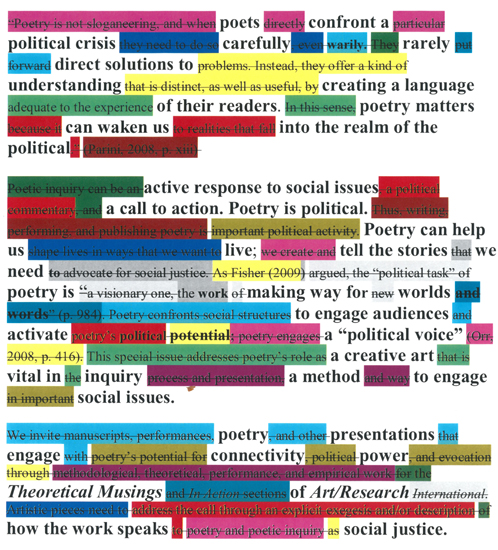An Inquiry into Self-Immolation as Social Protest
DOI:
https://doi.org/10.18432/ari29258Keywords:
poetic inquiry, ahimsa, non-violence, compassion, social protest, self-immolationAbstract
This poetic inquiry paper is a reflection on the phenomenon of self-immolation committed as compassionate protest. Whether the self-directed social protest of Vietnamese monk, Thích Quảng Đức, and Tibetan monastics and lay people, expresses selfless, altruistic action, dedicated to the greater good, merits reflection. Individuals seeking social justice in today’s troubled times may be interested in cultivating ahimsa, or non-violence, within themselves before attempting to implement it within their communities. In brief, they should change themselves before they change the world. With self-compassion that broadens to loving kindness and compassion for all, they may try to understand those from whom they seek justice before they commit to action. This inquiry concludes with ekphrastic poetry, “interpreting, troubling and addressing” (poets.org) the Tibetan painting, “Wheel of Life,” a depiction of the Buddhist concept of the “three poisons,” ignorance, desire, and anger, and contemplates their antidotes.References
Barthes, R. (1981; 2010) Camera Lucida: Reflections on Photography. (R. Howard, Trans.). New York, NY: Hill and Wang.
Biggs, M. (2005). Dying without killing: Self-immolations, 1963-2002. In D. Gambetta (Ed.), Making sense of suicide missions. Oxford, UK: Oxford University Press [PDF file]. Retrieved from http://users.ox.ac.uk/~sfos0060/immolation.pdf
Browne, M. (1993). Muddy Boots and Red Socks: A Reporter’s Memoir. New York, NY: Times Books.
Gandhi, M. K. (1958/2013). Mohandas K. Ghandhi: All Men are Brothers. London, UK: Bloomsbury.
International Campaign for Tibet (2012). Storm in the grasslands: Self-Immolations in Tibet and Chinese Policy. Washington, DC: International Campaign for Tibet. Retrieved from https://www.savetibet.org/storm-in-the-grasslands-self-immolations-in-tibet-and-chinese-policy/
Kumārajiva (4th C; 2007). The Lotus Sutra. (T. Kubo & A. Yuyama, Trans.). Berkeley: Numata Center for Buddhist Translation and Research. Retrieved from
http://www.bdk.or.jp/document/dgtl-dl/dBET_T0262_LotusSutra_2007.pdf
Mathers Museum of World Cultures. (2014, October 15). Tibetan Thanka Painting. [digital image]. Retrieved from https://www.flickr.com/photos/mathers_museum/15368827914/in/photolist-q5D9XD-qjNmTN-pq6g6C-pq6h7L
Nhat Hanh, T. (2001). Anger: Wisdom for cooling the flames. New York, NY: Riverhead.
Nhat Hanh, T. (2016, December). When Thich Nhat Hanh met a french soldier. Lion’s Roar, n.p. Retrieved from https://www.lionsroar.com/a-french-soldier/.
Self-Immolations by Tibetans (2017). International Campaign for Tibet. Retrieved from https://www.savetibet.org/resources/fact-sheets/self-immolations-by-tibetans/.
The bloody battle of Khe Sanh: 77 days under siege. (2014) Stars and Stripes.
Retrieved from https://www.stripes.com/news/special-reports/vietnam-at-50/the-bloody-battle-of-khe-sanh-77-days-under-siege-1.314627
Three Poisons: Greed, Hatred, and Delusion (2015). Suffering and Its Causes. Retrieved from http://buddhist-spirituality.com/three-root-poisons.
Wheel of Life (2017). Rigpa Shedra. Retrieved from http://www.rigpawiki.org/index.php?title=Wheel_of_Life
Woeser, T. (2016). Tibet on Fire: Self-Immolation Against Chinese Rule. [E-reader Version]. (Trans. Kevin Carrico). London, UK: Verso. (Originally published 2013). Retrieved from https://www.amazon.ca/Tibet-Fire-Self-Immolations-Against-Chinese-ebook/dp/B00WCY4YY0/ref=tmm_kin_swatch_0?_encoding=UTF8&qid=1510981313&sr=8-1
Published
How to Cite
Issue
Section
License
Copyright (c) 2018 Art/Research International: A Transdisciplinary Journal

This work is licensed under a Creative Commons Attribution-NonCommercial-NoDerivatives 4.0 International License.
Authors who publish with Art/Research International agree to the following terms:
a. Authors retain copyright and grant the journal right of first publication and the right to sublicense the Contribution, in the form in which it is published by the journal, to others under the terms and conditions of the of the Creative Commons Attribution-NonCommercial-NoDerivs (CC BY-NC-ND) that allows others to download the work and share the work with others with an acknowledgement of the work's authorship and initial publication in this journal, but they cannot change the work in any way or use any part of the work commercially.
b. Authors are able to enter into separate, additional contractual arrangements for the non-exclusive public distribution and display of the journal's published version of the work (e.g., post it to an institutional repository or publish it in a book), with an acknowledgement of its initial publication in this journal.
c. Authors are permitted and encouraged to post their work online (e.g., in institutional repositories or on their website) prior to and during the submission process, as it can lead to productive exchanges, as well as earlier and greater citation of published work (See The Effect of Open Access).
d. Authors wishing to include items (such as images or other media, or any creative works of others whether previously published or not) must contact the original copyright holder to obtain explicit permission to publish these items in Art/Research International. Writing permission should include: the title(s) of any copyrighted work, original place of publication if applicable, and an acknowledgement of having read Art/Research International's copyright notice. Authors are responsible for obtaining this permission and keeping it in their own records for later verification.



